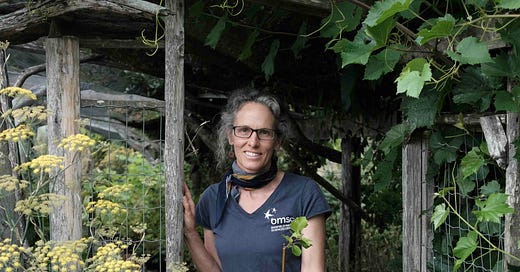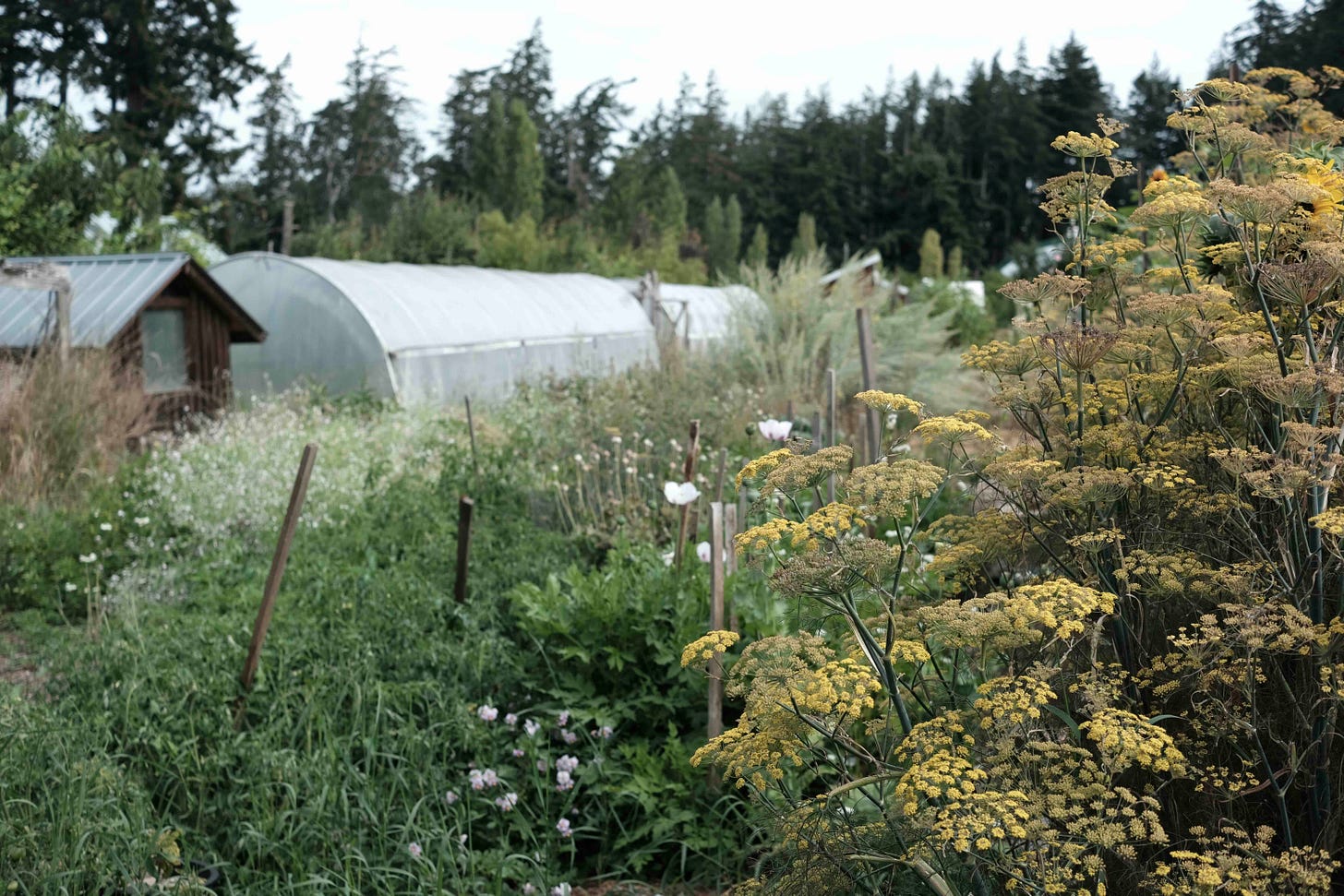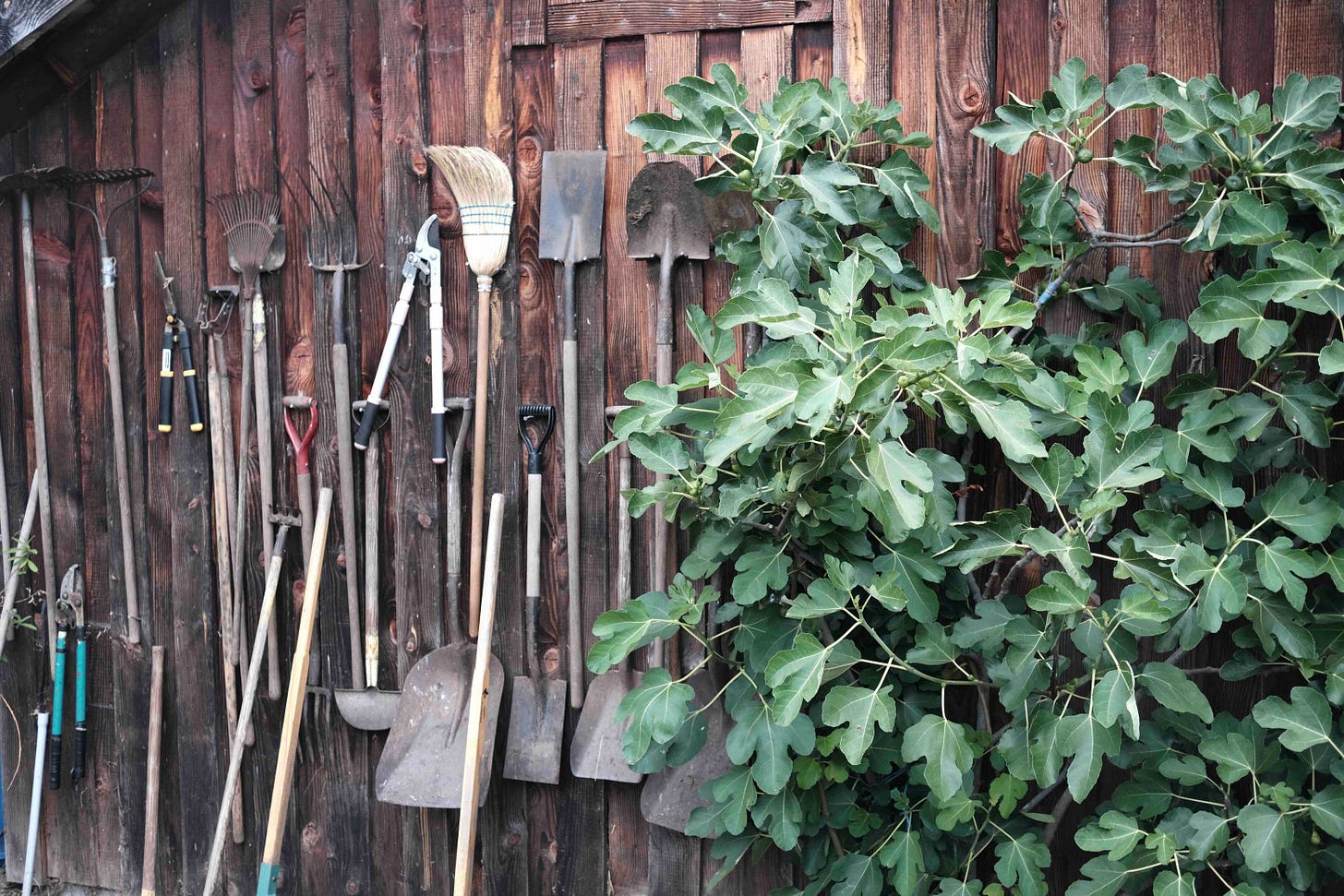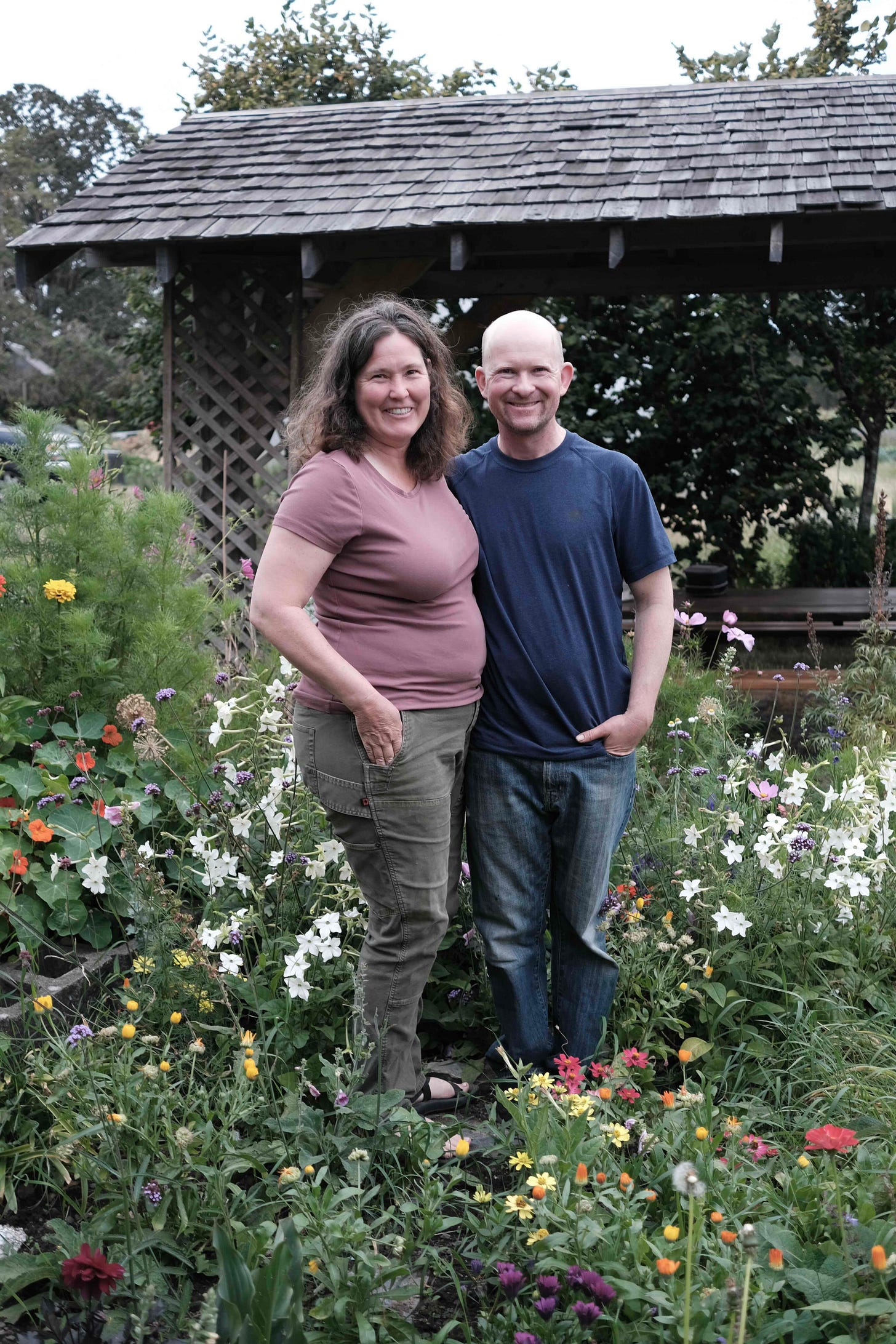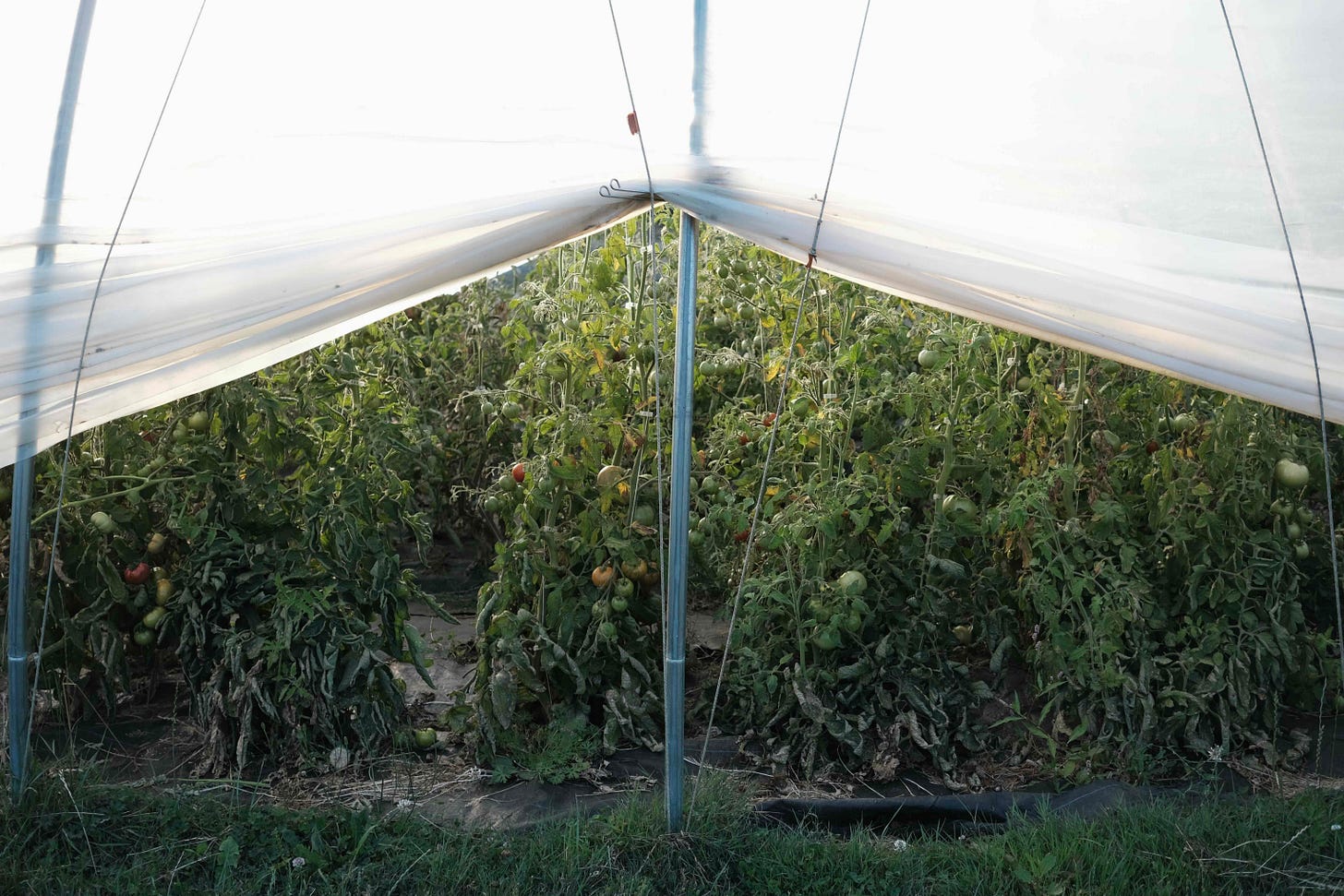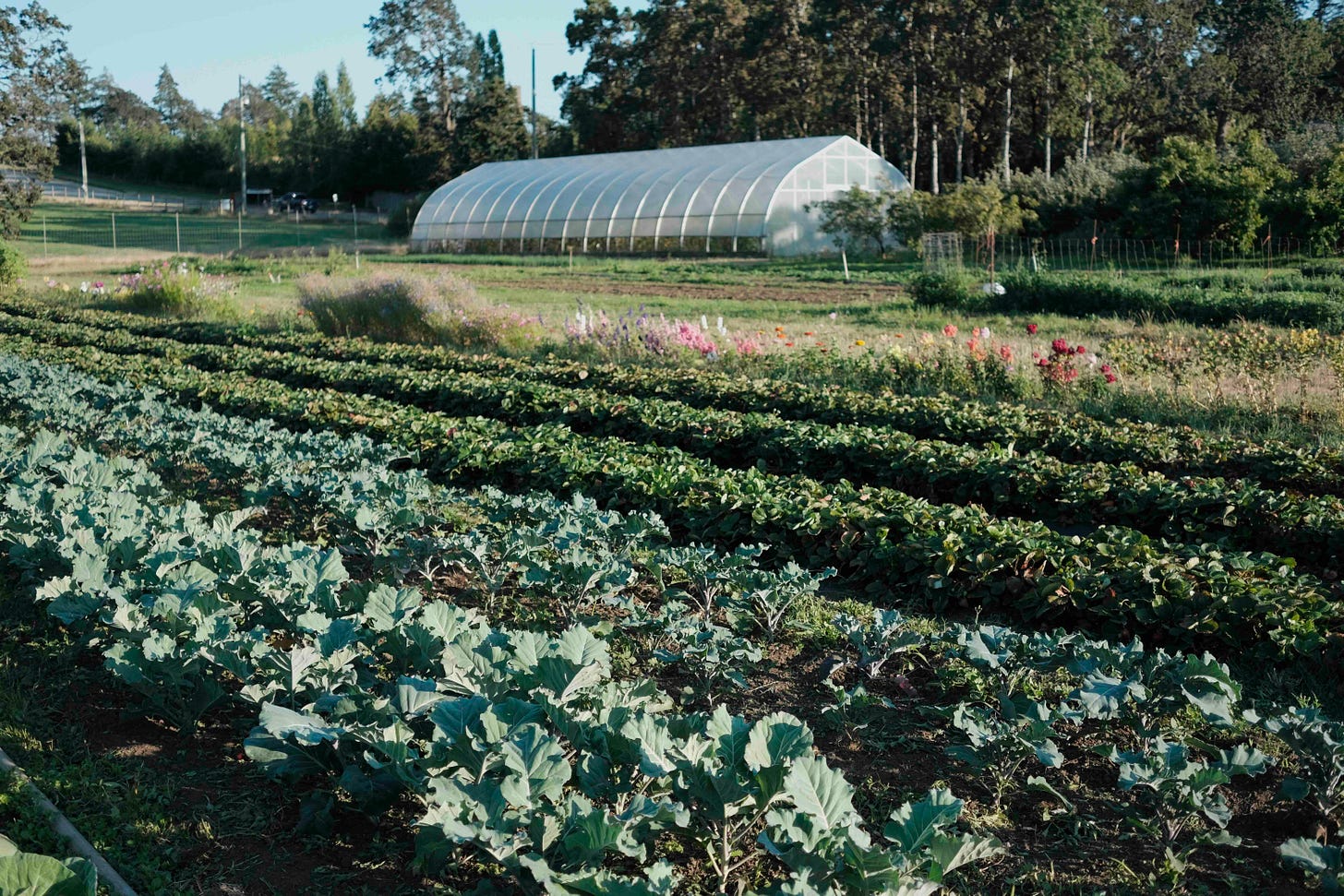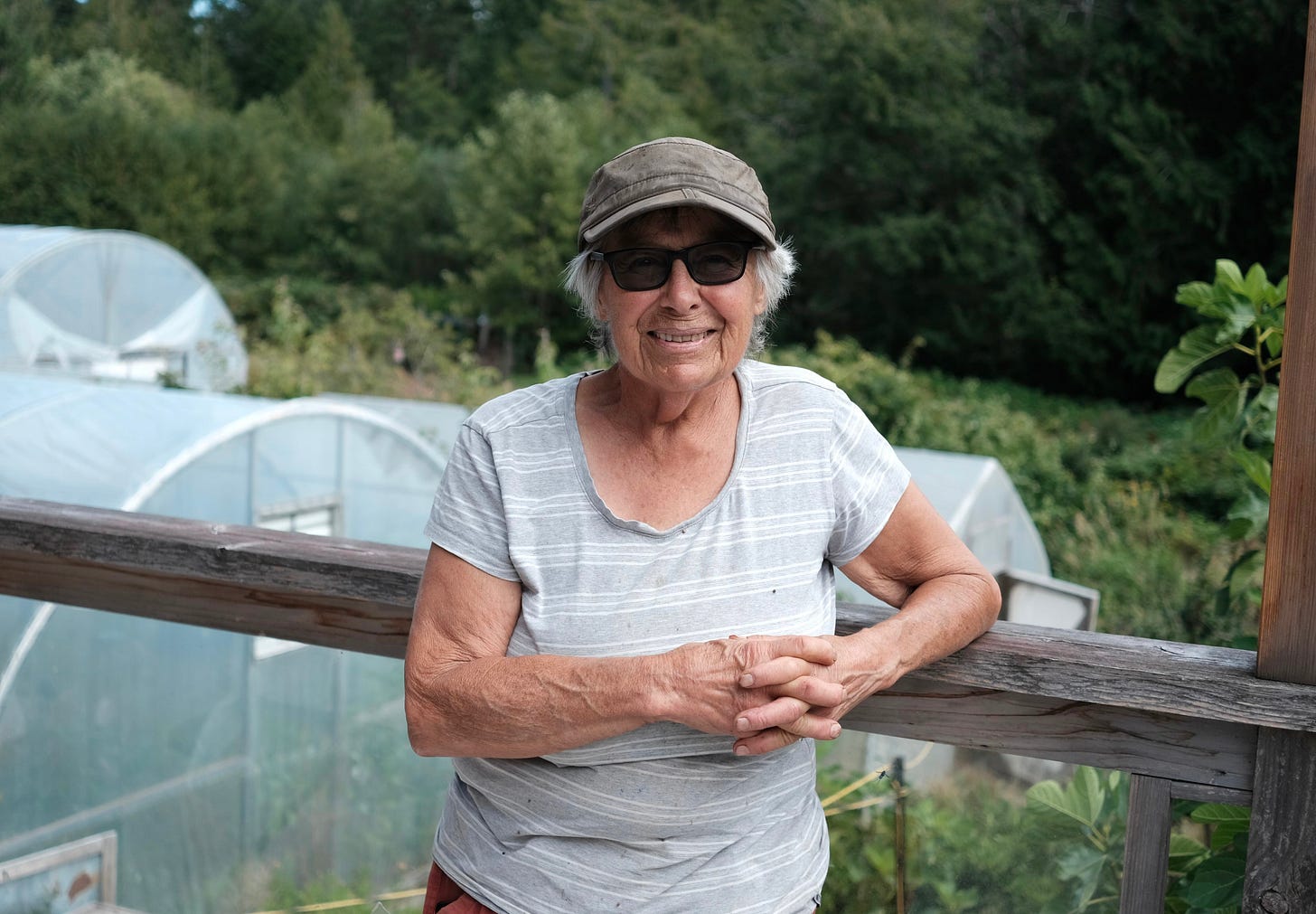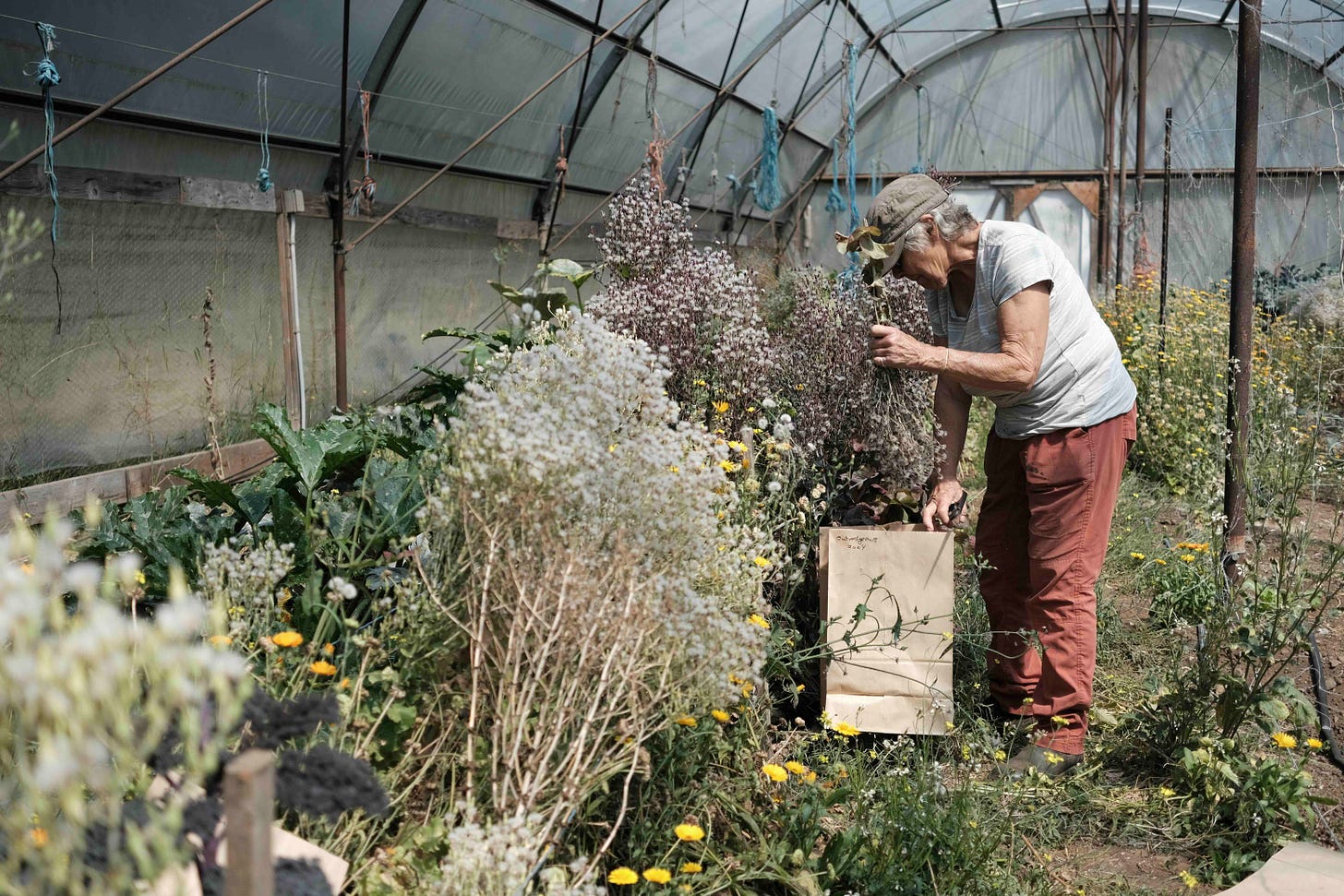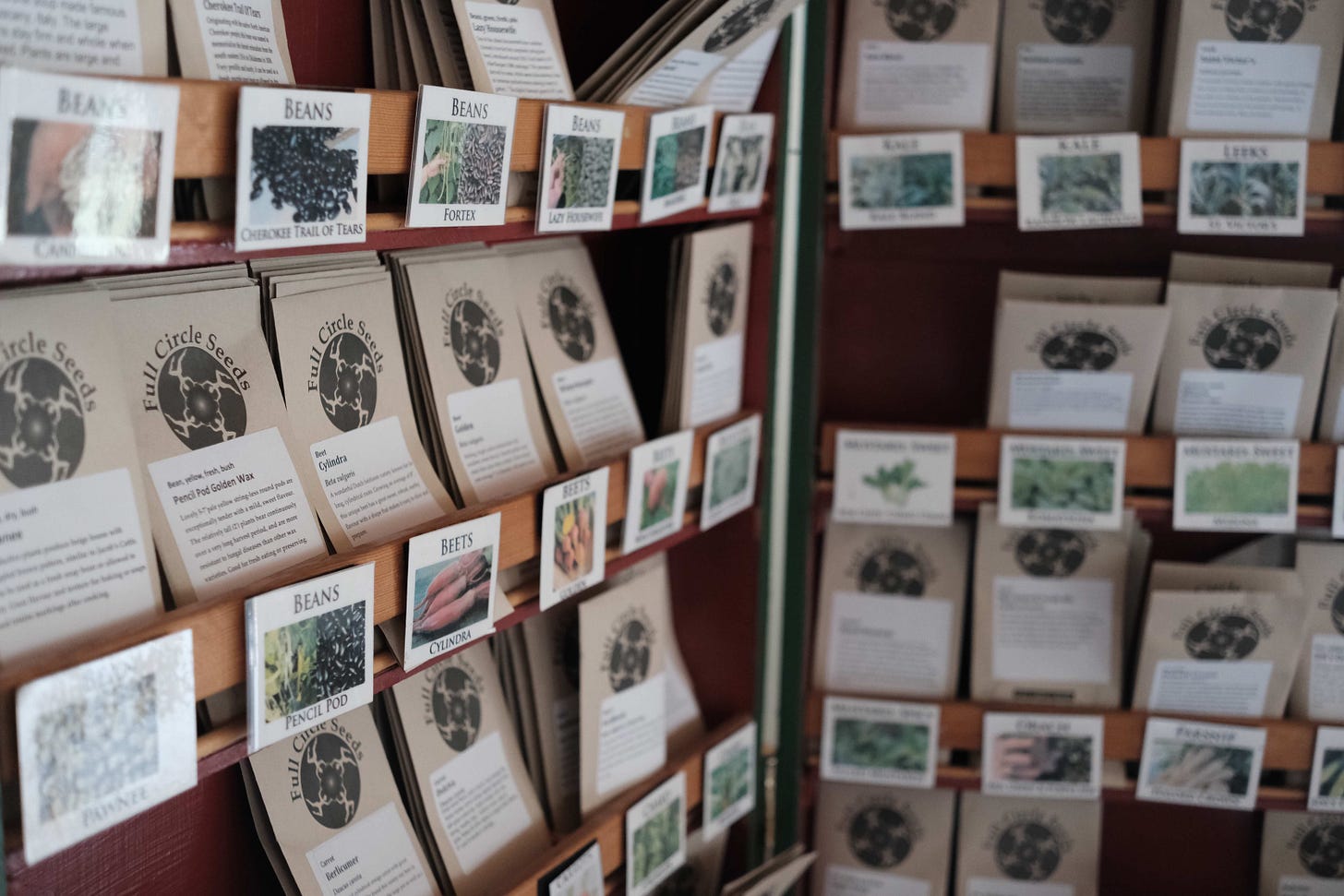Something that has become evident as I have met more and more people in this wonderful network of seed growers and allies, is that seed keeping seems to be intuitive. It is hard wired into us. Almost everyone participating in this work does it not because it’s going to make them rich or famous, but because it is instinctive, and they cannot imagine not doing it. Seeds and humans have co evolved since the beginning of our existence: we can’t seem to separate ourselves from seed, our stories are intertwined.
And a story that is common amongst many in this network is the seemingly accidental but ultimately intuitive way a lot of people found their way to seed. One of those ‘accidental seed farmers’ is Fiona Hamersley Chambers of Metchosin Farm.
‘I never started thinking I was going to do this. My favourite variety of spinach when I was market gardening disappeared from the catalogue I was getting it from, which was West Coast Seeds. And I thought they grew all their own seeds. So, I went to William Dam and I looked in that catalogue and it was gone from there and I thought that’s weird. Ok well I’ll go to Veseys because Veseys will have it, and it was gone from there too. And suddenly this light bulb went off and I thought, wait a minute, and I phoned each of them, and I said – do you grow your own seeds?’
Discovering that none of the seed she had been buying for use on her farm was grown locally, Fiona set out to become a seed keeper.
‘I had some of the seeds left of that variety, and I just started saving them, and suddenly I had a kilo of seeds and all I needed was a quarter cup, and that’s how it started. The accidental seed grower!’
That was in 2004, and Fiona has now been keeping seed for the last two decades. She offers a hugely diverse seed catalogue ranging from vegetables to fruit to grains and pulses alongside a native seed collection from her base at Metchosin Farm. Located in the rural outskirts of the island’s capital, Metchosin Farm was unlike any seed farm I had yet encountered. Perhaps reflective of her English heritage, the farm is a beautiful medley of seed crops, perennials, orchard and meadow, all meandering into one another offering soft edges and little sign of the typical regimented rows. The farm felt like an old English garden, fennel sprouting from cracks in the ground and vines clambering over weathered archways, surrounded by borders of lavender. It felt cosy, helped by its location - nestled in the rain shadow of the Olympic Peninsula - Fiona explained how it was possibly one of the best climates in the world for growing seed.
Although she seemingly stumbled upon seed saving, Fiona is no amateur. As well as stewarding heirloom varieties, Fiona is often creating new ones too. She is an avid plant breeder, and through meticulous observation for any off types and crosses in the crops she grows, she has nurtured several ‘Metchosin Farm Originals’. I was lucky enough to get to taste one of these on my tour – the Strawberry Cherry Tomato is a variety Fiona has been fine tuning for many years, sweet and tangy with a beautiful pinky colour, it was a treat to sample. Then there’s the chard that she has been selecting for unique colours and for resilience. She often earmarks plants that volunteer themselves around the garden, offering exciting new colour combinations and growth habits to add to the gene pool.
An ethnobotanist by trade, Fiona is no stranger to our profound historical relationship with seed. Alongside seed farming she has written and contributed to many books, and this background plays a fundamental role in her work. As Fiona showed me around her beautiful farm, she drew my attention to several crops and shared their rich history. One of these was a humble potato, and after digging around in the soil Fiona handed me one of the tubers:
‘There is this myth that people were hunters and gatherers – but people cultivated extensively here, it was not a wilderness. This potato is a proxy record for land tenure management’
The potato she handed me was a Haida potato, traded in the 1700s by Spanish conquistadors who arrived on the B.C coast, it has been cultivated by First Nations people in this area for over 250 years:
‘They were growing and trading these all the way down to California within 3 years.’
Suddenly I no longer just had a tuber in my hand, but the weight of centuries of co-evolution.
Something that has punctuated my conversations with many farmers on Vancouver Island is not only how we make this local seed work more possible, but also how we go about reconciling the history that often accompanies seed. As Simon at Good Earth Farm acknowledged – in the ‘modern western world’ we are often guilty of thinking we are the sole creators or owners of varieties – ‘but what about the 8000 years of seed saving that went on before you?’ This work involves dismantling the colonial mindset, and recognising that plants and humans have co-evolved for hundreds of thousands of years, any ‘new’ variety is the result of centuries of relationship and stewardship before us. Modern day seed stewards and plant breeders, even with their dedication and unique skill sets, are simply a continuation of that story. As we heal these relationships, perhaps it’ll become easier to acknowledge and remember.
‘When people say they have a black thumb and they can’t grow food, I say don’t be so arrogant! These plants have millions of years of evolution and sometimes thousands of years of coevolution with humans, they know what they’re doing, it’s pretty hard for you to mess it up. Just give them some basics of light water air and some decent soil and they’ll do the rest.’
Fiona is passionate about continuing this relationship through sharing her skills and inspiring others to get into seed saving. She offers experiential workshops on her farm, as well as educational sessions for young people.
‘What I think is critically important is the diversity of skill sets. We have a food skills lack - it’s the difference between shallow and deep ecology, where people say oh I should buy my food locally in the same way that you do recycling. But not really looking at what a local food system is, and if you don’t produce your seed… if you don’t have seed security you don’t have food security, and seeds often are almost entirely left out of the conversation.’
A stone’s throw from Fiona, fellow farmers Robin Tunnicliffe and Sasha Kubicek of Sea Bluff Farm are also passionate about placing seed at the centre of conversation when it comes to food security. Sea Bluff is a 10-acre farm perfectly positioned at the base of a gentle incline, sheltered from the nearby ocean breeze by a stand of beautiful old trees. Robin and Sasha kindly offered to host me during my visit to the south of the island, and I got to spend several wonderful days with them at their farm. Like many of the people I have visited, Robin considers farming to be ‘heart work’, and seed plays a central role at their farm.
Robin is one of the co-owners of Saanich Organics, a community of women farmers from small certified organic farms who work together to supply fresh local produce to the Greater Victoria region. Many of the vegetables grown on the ten acres at Sea Bluff Farm feed into the residential veg box scheme that Saanich Organics facilitates, and Robin and Sasha also host a farm stand on site offering delicious locally grown veg directly to their community throughout the week. Sasha left his role of an accountant several years ago to join Robin in farming full time, and with the help of a brilliant team they now grow an abundance of vegetables, fruit and seed for their local community.
The main focus of the business at Sea Bluff Farm is food production, but seed also has an important part to play. With concern over the narrowing corporate control of their seed supply and lack of regionally adapted organic varieties, Robin and her co-owners of Saanich Organics decided to become part of the solution by starting their own seed company: Seeds of the Revolution. They received mentorship from the BC Eco Seed Coop and the Organic Seed Alliance, providing them with the skills to produce the highest quality seed, and they now offer a diverse catalogue of locally grown varieties for both home gardeners and farmers. At Sea Bluff Farm, Robin and Sasha grow several seed crops on contract for Seeds of the Revolution, as well as saving many varieties for their own reuse.
I had some beautiful chats with Robin during my time at Sea Bluff Farm. A hugely empathetic and considerate human, seed keeping was a topic that seemed close to her heart, and a non-negotiable in her work as a farmer. Like Fiona, it hadn’t necessarily been her intention to grow seed, but the practice seemed to find her.
‘I was inspired to start seed keeping through (the late) John Navazio. I got involved in the Organic Seed Alliance, and I just loved energy of all the seed breeders when they’re all together, it’s so fun, and inspiring and refreshing and empowering. I think as a farmer there are just so many forces oppressing you and to have control over one little part of it, just feels so good…it gives me hope.
I went on an exchange to India and I saw the role that seed played in the lives of these small farmers, and it was just very inspiring, and it just kind of drew my attention to all the issues with seed.’
Robin recollected an experience during her travels that proved powerfully formative:
‘We were visiting a seed saver, a woman who had a hundred varieties. We were sitting down and having a Q&A, there was language barrier. I said if I was a new grower and I was coming to this area, what would you tell me to grow? And she looked at me, and I felt like she didn’t understand, there was a big pause, and I thought, is that the dumbest question that’s ever been asked or…
She paused, and then she had all these pots of seeds and she started rearranging them, and she said: Well, if it hasn’t rained for a long time but you think it’s going to rain, then you’re going to want to plant these ones. They won’t yield as much, but you’ll get a crop. If you think it hasn’t rained and it will not rain, then you want these ones, they germinate in atmospheric moisture, you know you won’t get a huge yield but you’ll get something. If you have a parcel of soil that is fertile you’ll want these ones. If you don’t have fertility then these ones…If you have old people in your family you’re going to want these ones because these grains are softer for teeth, and if you have babies...
She just went on and on. I was like, woah, I think about nothing, I just think about how I stay alive as a farmer, because it costs so much to grow all this stuff and I have to get a return on it and then labour is so much but it’s so worth it and I wish I could pay people twice as much. I’m just so market driven, but she was in this survival, thriving, ultimate community mindset. It was pretty humbling. It was this deep multilayered experience.’
This encounter beautifully illustrates how far-removed western culture has become from any intimate relationship with seed. Each of the varieties, or likely populations, that the woman described were deeply entangled with that community and with that very specific place and environment. They were part of the family.
Inspired by this encounter and subsequent travels, Robin has made sure that seed is at the heart of the business at Sea Bluff Farm. They make a point of stewarding and saving varieties that they know do well for them as market crops – responding to their community’s needs. They also trust in our ancestral connection with plants. Clubroot had been a problem at Sea Bluff Farm for decades, and previous owners has warned Robin from growing any brassicas on site. Not one to be deterred, and trusting that the plants might offer a solution, Robin started saving seed from plants that display any sign of resilience to the disease, along with experimenting with biological controls on the crops themselves. Several years later and there hasn’t been a case of clubroot for some time – in fact all the Brassicas I saw in the fields looked luscious and healthy. This required a leap of faith from Robin and Sasha, it required them to think beyond an instant fix, and ultimately trust in the relationship of reciprocity between themselves and the plants as their ancestors had.
Robin’s conversation with the seed saver on her travels in India also brought home to her how vital diversity is. Each of those varieties described by the woman were for a very particular situation, whether that be climactic or cultural or community driven.
‘Diversity to me is, when I get clubroot, there are strains of Brassicas that can overcome that, I need that breeding I need access to that. There are varieties that have coexisted with clubroot for millennia. Where are those? We need those. That’s what we need to feed people. The tomatoes that can deal with the extremes. I think Canada has such a varied climate, we have the high arctic and they’re growing tomatoes up there and they can kick it because they have their 20 hours of sunlight, but they can’t grow the same ones that we have here. So, they need breeding for far north short season, so there are things that can work for them. One thing that scared me was realising how much seed is grown in the central valley of California, and how much food is grown there. Large seed companies are just motivated to grow for that small climate that is obviously perfect for many vegetables. But what if I live on a cold wet windy coast? We need varieties that work here.’
Through embracing the practice of seed keeping, Robin and Sasha now have several varieties of brassicas that demonstrate clubroot resistance, a winter hardy chard, and many other crops that thrive on their farm through this intentional stewardship.
‘Dealing with the seed, it just reminds you of how generous nature is. It’s such a generous process, you plant one plant and that plant will give you hundreds of seeds. What more do you need? Seed is such a grounding thing, it just shows you how abundant the world is and we just take, and we don’t think about what abundance we’re given.’
Another farmer acutely aware of the generosity of plants is one of Robin’s mentors - Mary Alice Johnson of Full Circle Seeds and ALM Organic Farm. Mary Alice has been a farmer and seed keeper for over 30 years: a true elder and a knowledge keeper, meeting Mary felt like a significant moment in my travels and an encounter I won’t forget in a hurry.
Mary Alice has been farming at her 15 acre organic farm in Sooke, in the south of Vancouver Island since 1994. While I was staying at Sea Bluff Farm I made a day trip out to visit Mary. Primarily growing vegetables to feed her local community, she too started exploring seed almost by accident:
‘The first year I was farming, there was a bunch of runners left on the vine, they had dried, they were you know the rejects. But I collected them and I just sat in the grass in the Fall and shelled them and they were so beautiful. And I said, I want to do this for the rest of my life! It was that that really grabbed me, the seed part of it was so beautiful, the whole completion.’
She quickly learnt that saving from the rejects was not the way you were ‘supposed to save seed’, but by then she was hooked. Mary has been producing seed ever since, saving almost all of her own for reuse on the farm, alongside offering a diverse catalogue for sale through her seed company, Full Circle Seeds. Like several of the farmers I have encountered on my travels, Mary artfully combines market vegetable production with seed saving, and heartily believes one compliments the other.
‘You get a lot of feedback from the customers that eat your food, they’ll tell you oh that’s really delicious – now that’s good feedback for seed saving!’
The culinary aspect of a variety is important to Mary – varieties that make it into the Full Circle Seeds catalogue must prove their worth in the kitchen and taste delicious. And not necessarily for cooking, but also for preserving beyond the summer months. While I was visiting, we spent an hour or so at her nearby house and chatted over coffee as Mary prepped and canned the glut of courgettes from the farm.
‘Yesterday we had a farm stand and people came down and we talked about the food they were buying and their lives, and it’s just a real connection with them, and them eating the food. And I’ll see them next week, and the next week, and the next week. There’s a huge connection with people and I love that. I never thought I’d enjoy selling stuff, I was a teacher before I started farming and I always thought selling stuff wasn’t that cool. But now I find my selling is often teaching, when I sell something I’m often teaching them something about it.’
There is intention and connection behind every variety that Mary Alice grows, nothing is grown just for the sake of it. As a seed ‘elder’ with a reputation as a talented seed steward, she has been given many varieties over the years by family, customers, neighbours, or those simply wanting an unusual crop to be made available to others within their local community. All of these varieties hold a story and are unique, and Mary works hard to ensure their stories continue far beyond her stewardship.
My day spent with Mary was simply wonderful. The sheer pleasure and delight she finds in her work was palpable, and we sat for several hours discussing her journey over the years. Part of the emerging seed movement back in the late 80’s and early 90’s, Mary fondly recalled attending some of the early meetings of those involved in the Abundant Life Seed Foundation and the subsequent formation of the Organic Seed Alliance. She has known and followed the work of fellow seed keepers such as Frank Morton for decades, and it was a privilege to listen to her memories of the movement here in the Pacific Northwest. My lasting memory of my time with Mary Alice will be the sheer joy she seems to find in her work. Her eyes sparkled with excitement as we inspected and harvested the ripe lettuce seed, and there was such an intuitive peace that fell over her as we cleaned seed in the barn loft later in the day. Like so many others on this journey, it’s hard to distinguish who found who, if Mary found the seeds or if seed work found Mary, but her love for it all seems timeless.
‘It’s a full circle, there is a beginning a middle and an end, and why would you not want to see it all. Why wouldn’t you?’

